Goldendoodles are friendly, happy-go-lucky dogs that can make wonderful family pets.
As well as their excellent temperament, Goldendoodles are loved for their looks. Let’s be honest, who couldn’t be beguiled by that super-cute Teddy Bear face and delightfully soft, fluffy Goldendoodle hair.
But did you know that Goldendoodles generally change their coat color as they get older? There are several Goldendoodle types of coats. If you’re asking yourself what coat will my Goldendoodle have, you’re in the right place!
Keep reading to learn about types of Goldendoodle coats and find out what kind of fur your puppy will have when he grows up.
Table of Contents
What Are The Goldendoodle Coat Types?
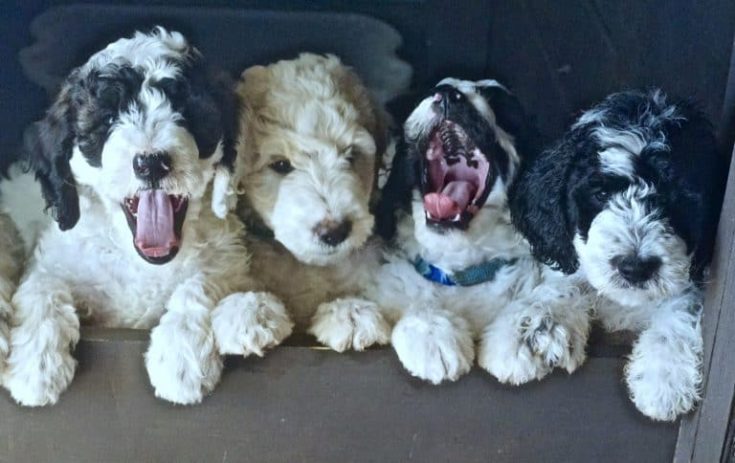
There are four primary Goldendoodle coat types:
- Flat
- Wavy
- Straight
- Curly
The flat coat is also commonly called an “improper coat.”
What Are Furnishings And Improper Coat?
“Furnishings” is the term that’s used to describe the beard, mustache, and eyebrows that give the Goldendoodle its trademark, shaggy teddy bear look.
Goldendoodles with what’s commonly called an “improper coat” are the least popular type of this breed. Flat-coated Goldendoodles don’t have furnishings, so they tend to look more like a Golden Retriever. Flat coats are quite commonly seen in F2 Goldendoodles.
These coats are easy to maintain when compared with curlier coated types. However, if you want a Goldendoodle that has the traditional teddy bear look, a flat-coated dog is not for you. Also, these dogs are moderate to high shedders and are, therefore, not recommended for a family with allergies.
Straight Coat
Goldendoodles that take one “non-curl gene” from each parent dog will have quite straight coats. However, unlike flat-coated Doodles, the straight coat type does have furnishings and the fur tends to be fluffier in texture.
Straight coat Goldendoodles are also referred to as loose coats or hair coats, and these pups have coats that are most like a Golden retriever. Although you won’t have to spend too long grooming your straight coat Goldendoodle, your dog still needs regular brushing to prevent the coat from forming mats and knots. Daily brushing is ideal if you have enough time to devote to that, but you must make sure that you work right through the fur right down to the dog’s skin.
Also, these dogs do tend to shed quite heavily, making them unsuitable for those with pet allergies. So, if you take on one of these Goldendoodles, you must also be prepared to vacuum your carpets daily!
Wavy Coat
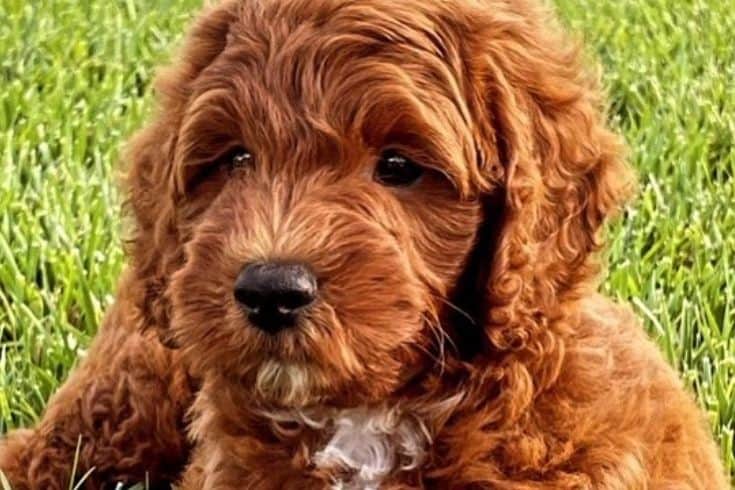
Wavy coat Goldendoodles take one non-curl gene from one parent dog and one non-curl gene from the other, producing a wavy coat. A wavy or shaggy coat is the most common type of Goldendoodle coat type, and they are also sometimes called fleece coats. In fact, the wavy coat occurs in all the most popular generations of Goldendoodles, including F1, F1b, and multigenerational dogs.
These mixed breeds have a shaggy appearance and they need brushing regularly, at least once each week, especially in high-friction areas, such as under the collar or around the dog’s ears. If you neglect to groom your Goldendoodle, mats will form that can be impossible to remove without resorting to shaving the dog’s hair. It’s beneficial to bathe your Goldendoodle periodically. Make sure that you brush your dog’s hair thoroughly to remove any knots before using a high-quality dog shampoo on your dog.
Wavy Goldendoodles can be minimal shedders, although F1 and F2 dogs tend to be moderate to heavy shedders. So, to be certain as to whether your puppy will shed or not, always choose a reputable breeder that has had all their breeding dogs DNA tested.
Curly Coat
Curly coats are created when the puppy inherits a curl gene from each parent. These dogs have very dense, fleece-like coat characteristics that most closely resemble the coat of the Poodle parent. You will most commonly find curly coats in an F1B Goldendoodle or some of the multigenerational Goldendoodles. Curly hair can be wooly or loosely curled, although most of these dogs don’t finish up as curly as a purebred Poodle.
To prevent deep mats from forming, you’ll need to brush your dog often. However, most owners prefer to have their dogs shaved or clipped. That makes it easier to maintain the dog’s coat, and there are plenty of smart haircuts to choose from.
Curly Goldendoodles are minimal to non-shedding coats, which makes these dogs extremely sought after by people with pet allergies. Although F1B Goldendoodle or multigen Goldendoodles are most commonly curly-coated, you can only be certain of your puppy’s likely coat type by using a breeder that has the breeding dog’s DNA tested.
If you leave the coat to grow without having your dog clipped, the curls will become very dense, making it difficult to gauge their length simply by looking at the coat. That said, eventually, the hair will stop growing. The hair around the dog’s face is typically shorter that gives the Doodle a blown-out, voluminous “afro” look when it’s brushed. Something to be aware of is that these short, curly coats do tend to trap dirt and sand close to the skin if you don’t keep on top of grooming your Goldendoodle.
How Old Will My Goldendoodle Be Before I Know The True Coat Type?
When your Goldendoodle puppy’s coat is likely to transition to his adult fur varies from dog to dog. Generally, a Doodle puppy “blows his coat” and gets his adult hair when he’s between five to eight months of age.
How Can You Tell What Kind Of Coat Your Goldendoodle Will Have?
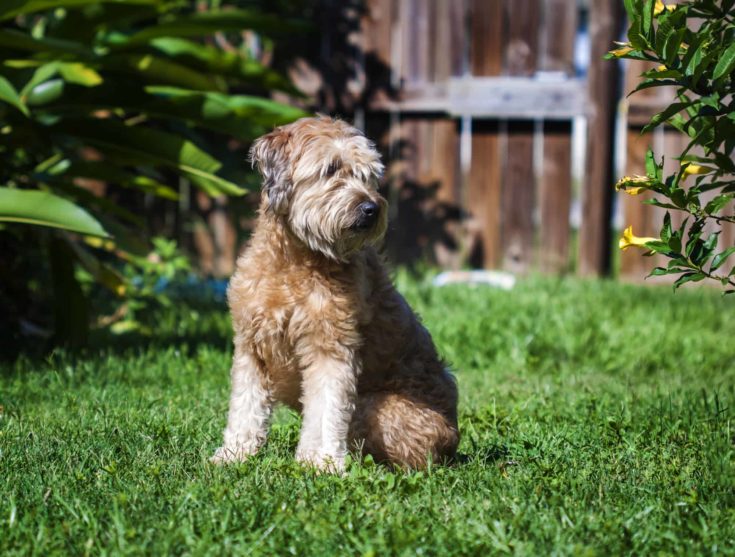
It’s extremely difficult to tell what kind of coat a Goldendoodle puppy will have when he grows up, as puppy coats all look very similar. To make matters even more confusing, Goldendoodles commonly change color as they mature.
An experienced breeder that uses DNA testing on their breeding dogs will be able to tell you what each puppy’s coat type will be like in adulthood with a fair degree of accuracy. However, you can make an educated guess as to your puppy’s adult looks. Generally, if the puppy has a smooth face without furnishings, he will most likely have an improper or flat coat.
Goldendoodle Coat Stages
As previously mentioned, Goldendoodle puppies begin shedding their puppy coats once they reach around six months of age. By the time your puppy is eight months old or more, he will have his final adult coat.
The final coat is usually not as soft and fluffy as the puppy coat. The coat change can be gradual or sudden, taking a matter of weeks or several months. In fact, when the coat change is very gradual, many Goldendoodle owners don’t even notice that the change has happened. Also, some super-soft adult Goldendoodle coats are virtually indistinguishable from the puppy coat.
Genetics And Coat Types
Your puppy’s genetics will determine what kind of coat type he will have when he’s fully grown. Until recently, crossbreeding dogs generally gave unpredictable results with the puppies taking more after one parent than the other. Now, DNA testing is commonly used by good breeders to determine what kind of coat their puppies will have. However, there are a few tried and tested methods of determining what kind of coat the puppy will have as an adult.
Look At The Puppy’s Snout
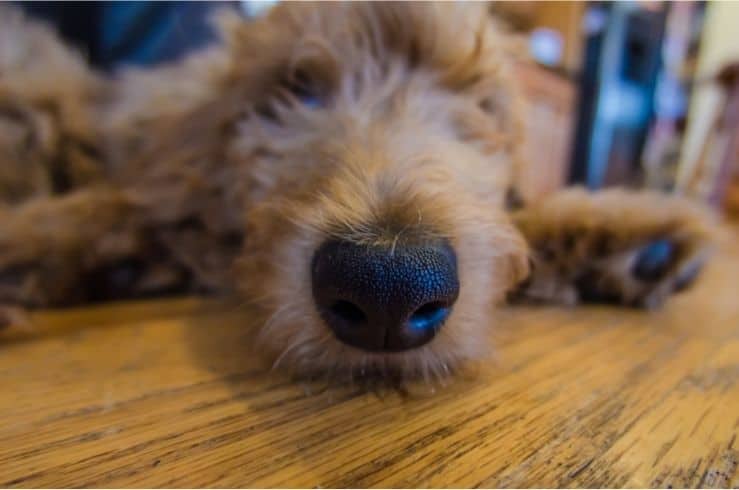
Take a close look at the way in which the fur is growing around your puppy’s snout. That can be a good indicator for the coat type your dog will have as an adult.
- Generally, a prominent mustache is a clear indicator that the puppy will have a curly coat.
- Dogs that will go on to develop wavy coats tend to grow a shaggy beard around the muzzle.
- Straight-coated Goldendoodles usually have short, neat hair around their snout.
If the puppy is anything other than an F1, first-generation pup, look at both the parent dogs. Generally, puppies take after one parent dog. So, if both parents have wavy, fleece coats, it’s highly likely that the puppies will also have loose, straight hair that sheds. Likewise, if the parent dogs have curly coats and are very low shedding, it’s probable that the puppies will be the same.
However, genetics always have the final say when it comes to coat types. So, although you can make an educated guess as to what kind of fur your Goldendoodle will have when he’s fully grown, there will always be a few big surprises. That’s just one of the things that makes owning a Goldendoodle puppy so very exciting!
Inspiration For Names!
One of the fun things about owning a Goldendoodle is choosing a name for your dog. And it’s often the puppy’s looks that can provide inspiration for your dog’s moniker!
For a few more ideas on what names you can choose for your Doodle puppy, check out this guide!
Why Doesn’t My Goldendoodle Look Like A Teddy Bear?
Most people think of the Goldendoodle as having those classic teddy bear looks that everyone finds so adorable. However, not all puppies go on to develop that wavy or curly coat and furnishings that are so desirable. And, of all the generations, the F1B Goldendoodles are much less likely to have a significant coat change as they mature, although the coat coarseness and density are quite likely to increase.
So, how come some Goldendoodles don’t develop the eyebrows, beard, and mustache (furnishings) that’s so characteristic of the breed. Well, as explained later in this article, that’s all down to genetics.
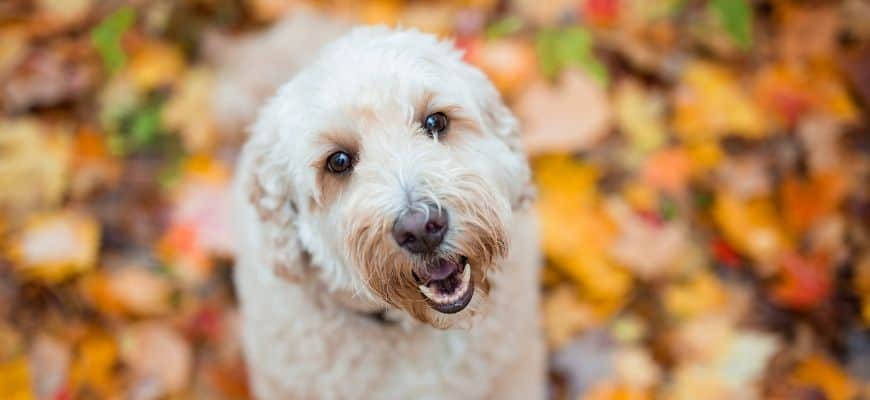
Interestingly, English Goldendoodles are more likely to have that boxy teddy bear features than American Goldendoodles. However, both kinds can develop the teddy bear appearance with the correct furnishings. Dogs with any of the three types of Goldendoodle coats can be with or without furnishings. F1 Goldendoodles are most likely to be without furnishings. F2 or F1B Goldendoodles are 75% Poodle and usually do display furnishings.
If you desperately want a dog with furnishings, it’s worth noting that a puppy that doesn’t have them is unlikely to develop them when he transitions to his adult coat.
The Science Of Goldendoodle Breeding For Coat Type

The Goldendoodle Association of North America (GANA) is heavily involved in helping breeders in their quest to produce the perfect Goldendoodle.
That involvement entails providing access to the very latest research and expert guidance on canine reproduction, breed development, and puppy development. Although health and temperament are any reputable Goldendoodle breeder’s primary concern, the look of the dog is also critical, since it’s that that turns heads and tugs at the heartstrings of potential Doodle parents.
There’s always an element of unpredictability when it comes to a Goldendoodle breeding program. However, through the careful selection of mates, a good breeder can produce that adorable Teddy Bear look that people love so much. Shedding intensity can also be predicted through careful DNA research and careful breeding.
Coat Length
Coat length is determined by the FGF5 gene. That gene governs whether the dog’s coat is long (L) or short (S).
Long coats are recessive, but since both the parent breeds are long-coated, all Goldendoodles have two L/L genes for a long coat. The S gene that gives the dog a short coat is dominant. So, if the dog has S/L genes, the coat will be short. That’s why many Labradoodles have short coats in the early generational dogs, whereas Goldendoodles don’t.
Curly Coats
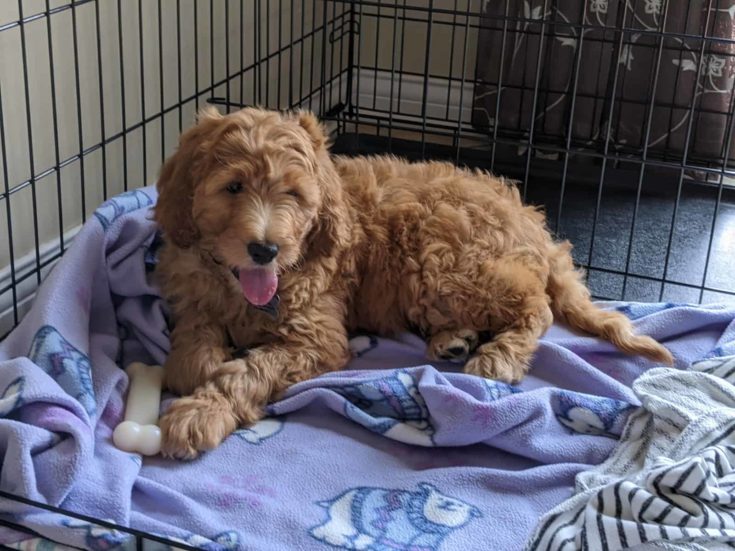
Curly coats are determined by the KRT71 gene. Doodle coats can be curly, straight, or wavy, depending on the number of curl genes that they take from their parents.
Goldendoodles that have curly coats have +/+ genes. Straight or flat-coats are -/- for curls, and dogs with loose curls or a wavy coat are +/-. A wavy coated Goldendoodle might have a curl gene (+/-), if you breed two wavy coated dogs, can theoretically produce all three coat types. So, if a breeder tests the parent dogs to see if they carry the curl gene, it’s possible to better predict their puppies’ appearance.
What Are Furnishings?
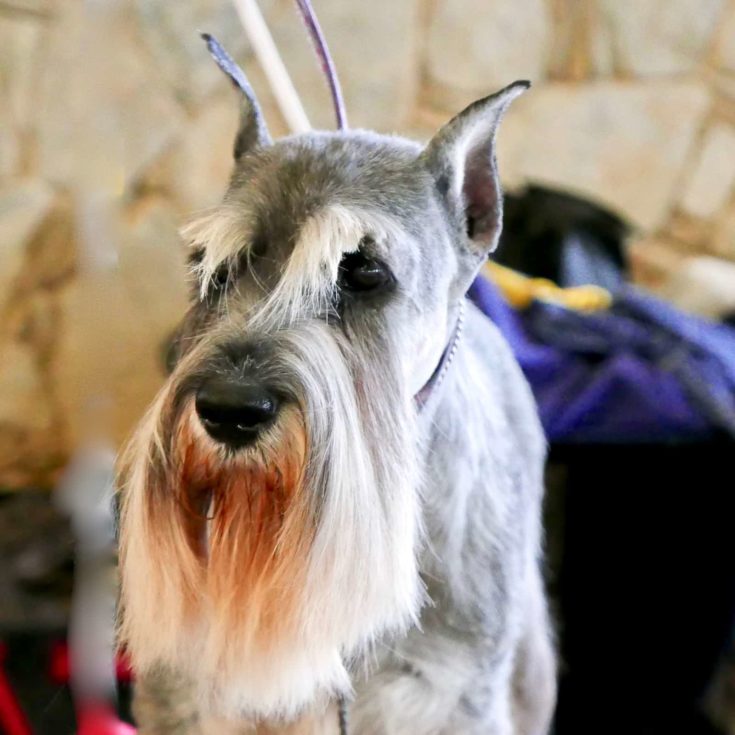
Furnishings are the term that’s used to describe the Goldendoodle’s characteristic long facial hair, including the beard, eyebrows, and mustache. Commonly known as the F gene, the gene, RSP02 is responsible for those furnishings.
It was once thought that curl and the “shedding” gene determined whether a Goldendoodle would shed much. However, now it’s understood that it’s the dog’s furnishings that confers those sought-after low to non-shedding Goldendoodle coats. Thanks to newly available genetic tests, it’s now possible to test parent dogs for furnishing and other coat genes so that it’s easier to predict coat type in Goldendoodle puppies.
So, if you want a low-shedding Goldendoodle with the “furnished look,” find a breeder that carries out genetic testing rather than using guesswork.
Improper Coat
A coat that has no furnishings is known as an improper coat or IC. So, there are several possibilities for this gene:
- FF
- Ff (or IC)
- ff
- IC IC
Since the furnishings gene is dominant, by testing the breeding dogs’ DNA, a breeder can determine if all the puppies will have furnishings or whether there will be some pups that have an improper coat.
Goldendoodles that have (Ff or F IC) or one copy of the furnishings gene tend to be lighter shedders than dogs that do have furnishings. Those with two copies of the furnishing genes (FF) usually don’t shed at all, making these dogs ideal for people with pet allergies.
In Conclusion
So, now you know all about the different coat types that Goldendoodles can have and you have an idea of how to predict your puppy’s future fur. I hope you enjoyed this guide!
Goldendoodle coats can be wavy, straight, curly, or “improper.” The only way to be certain of how your puppy’s coat will turn out is to choose a puppy from a reputable Goldendoodle breeder that has their breeding dogs DNA tested. These days, the guesswork has been taken out of predicting a Goldendoodle puppy’s adult coat type by the miracle of DNA testing and genetics.
What kind of coat did you think your puppy would grow, and how did it actually turn out? Tell us in the comments box below.